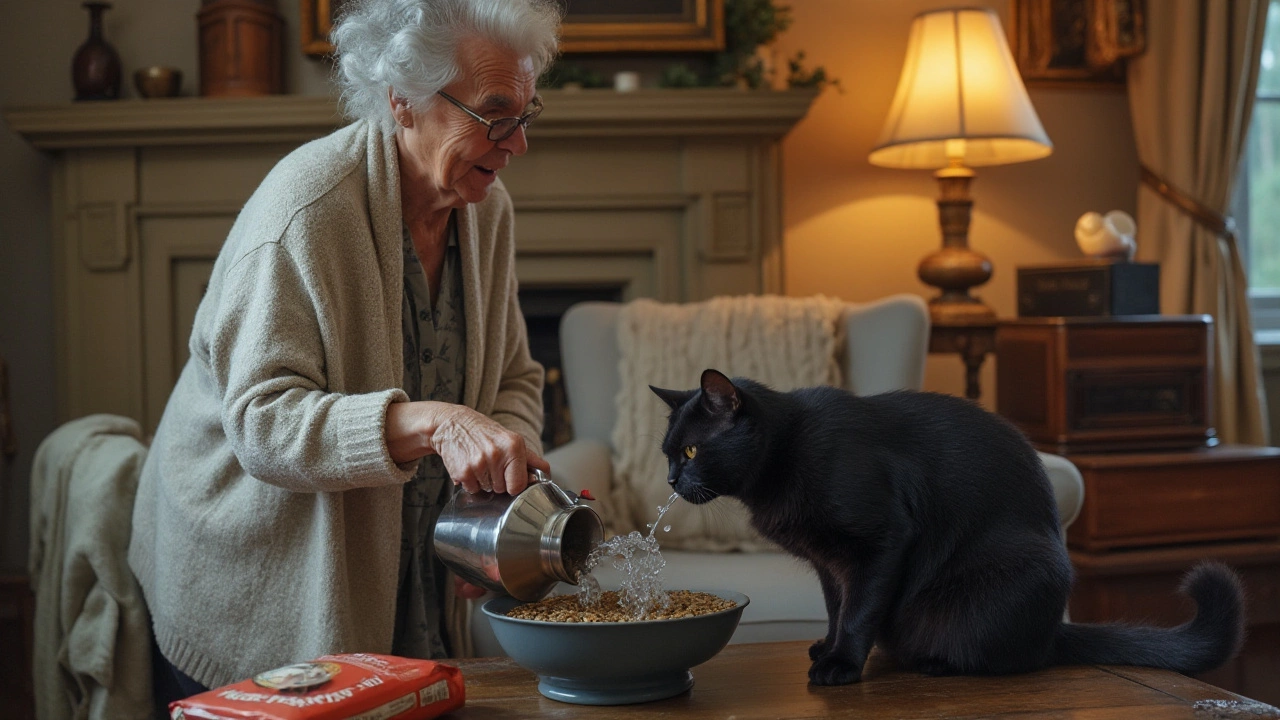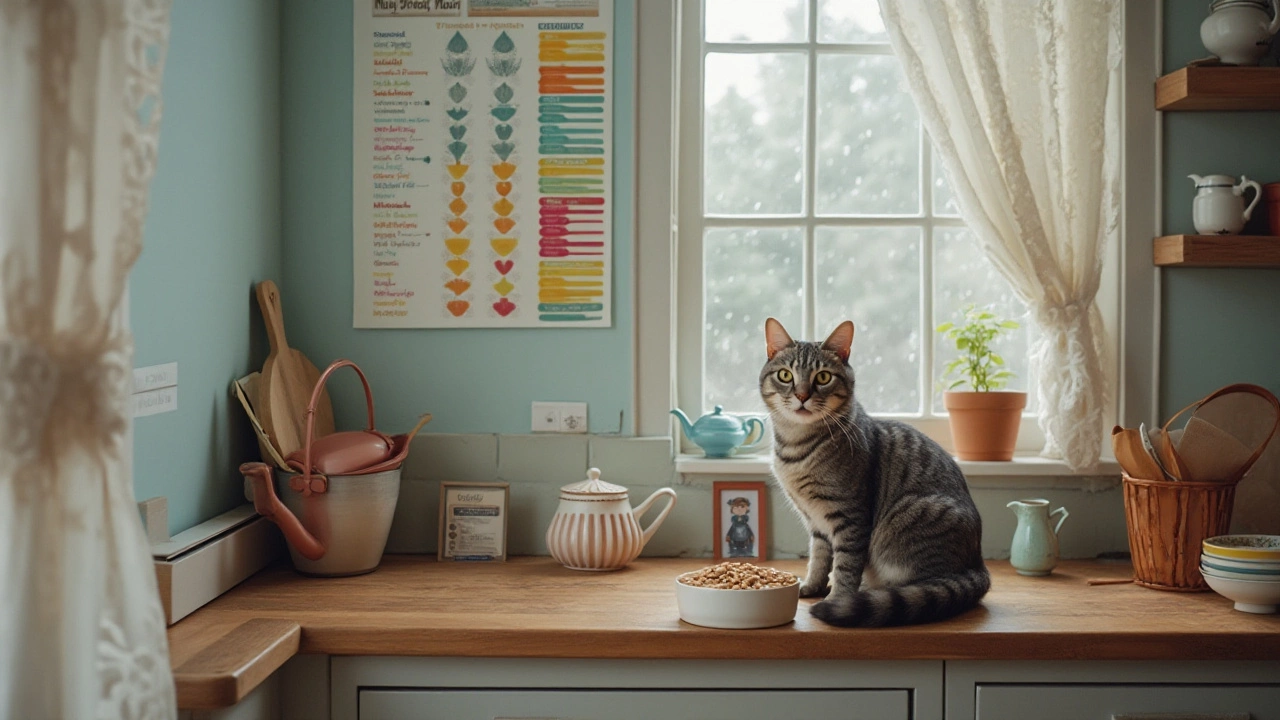Cats are fascinating creatures with unique dietary needs that have been shaped by their history as obligate carnivores. Many owners choose dry food for convenience and cost-effectiveness, but is it enough to keep your cat healthy and happy? As guardians of these independent animals, it's crucial to understand the pros and cons of a dry food-only diet and how it fits into their nutritional requirements.
While considering your cat’s diet, one must acknowledge how different their needs are from other pets. Cats have specific protein, fat, and moisture requirements that are best met with the right balance of food types. This article will delve into what makes dry food a viable option, potential challenges it presents, and how best to supplement it for a well-rounded diet.
- Nutritional Needs of Cats
- Understanding Dry Cat Food
- Benefits of Dry Food
- Potential Drawbacks
- Tips for a Balanced Diet
Nutritional Needs of Cats
Cats, unlike dogs or humans, are obligate carnivores. This means their diet naturally focuses on a high intake of animal proteins. Their bodies have evolved to rely on nutrients found specifically in animal tissue, making protein not just a preference, but a necessity. Proteins are crucial for maintaining their lean muscle mass, healthy skin, and glossy fur. Amino acids like taurine, which are found predominantly in meat, are particularly vital. Taurine deficiency can lead to severe health problems like heart disease and vision issues in cats. Therefore, when choosing a diet, ensuring sufficient animal protein is fundamental.
Fat also plays a significant role in a cat's diet, providing not only energy but essential fatty acids. These fats contribute to maintaining heart health, supporting the absorption of fat-soluble vitamins, and giving their coat a healthy sheen. Without these, cats might develop flaky skin or hair loss. Carbohydrates, in contrast, aren’t essential for their survival but are often included in commercial cat foods. It's necessary to remember that while cats can digest carbohydrates, they don’t need them in high quantities as part of their diet. Balancing these macronutrients is key to catering to your feline's unique dietary requirements.
Vitamins and Minerals
Cats require an array of vitamins and minerals to support their metabolism, bone development, and immune function. Vitamin A and niacin are particularly important and unlike humans, cats can't metabolize carotene into vitamin A, nor can they make niacin from tryptophan. These must be provided directly in their diet. Minerals such as calcium and phosphorus are essential for skeletal health, while iron and zinc support vital biochemical processes. An imbalance, whether excessive or deficient, can trigger various health concerns. For example, vitamin D toxicity could lead to kidney damage.Hydration represents another critical component of a cat's nutritional pattern. In the wild, cats obtain most of their water needs directly from their prey, which consists of about 70-80% water. A diet that exclusively consists of dry food could pose a risk of dehydration if fresh water isn’t always available. Some experts mention that a moist food diet can help mitigate this issue, although, like all things, a balanced approach is best.
"Every pet deserves a healthy diet that respects their natural instincts," says Dr. Jane Smith, a renowned veterinarian specializing in feline nutrition. "Understanding the unique needs of cats is the first step in providing them with a diet that supports their vibrant and active lives."It's crucial to consider these factors when assessing if dry food alone is suitable for your cat. A comprehensive understanding of their dietary needs can guide pet owners toward making informed decisions, ensuring their furry companions lead healthy and gratifying lives.
Understanding Dry Cat Food
Dry cat food, commonly referred to as kibble, has become a staple in many households due to its convenience and affordability. It's an enticing option for busy pet owners, providing a readily available solution to meet their feline's dietary needs. But what exactly goes into those crunchy morsels? At its core, dry cat food is made from a combination of protein sources, including chicken, beef, or fish, alongside grains, vegetables, and other carbohydrates. These ingredients are mixed with vitamins and minerals to ensure a balanced diet, then baked or extruded into the distinct shapes we recognize. The extrusion process involves heat and pressure, which not only shapes the kibble but also helps eliminate potential pathogens, making it a safe option.
It's important to note that dry food typically contains between 6-10% moisture, significantly less than a cat's natural prey which is over 60% water. This difference requires owners to carefully monitor their cat's hydration, especially since felines are notoriously low drinkers. Interestingly, dry food's low moisture content may lead to urinary tract issues if cats are not encouraged to drink adequate water. According to a study published in the Journal of Feline Medicine and Surgery, ensuring access to fresh, clean water can help offset this risk.
While evaluating dry food, pet parents often encounter a plethora of options, each boasting unique benefits. Selecting the right formula involves considering factors like the protein percentage—a vital component since cats thrive on a high-protein diet. Generally, quality kibbles offer at least 30% protein content, ensuring that your cat gets the necessary amino acids it cannot produce on its own. Some brands incorporate specific fats, such as omega-6 and omega-3 fatty acids, which are known to promote healthy skin and a shiny coat. Additionally, antioxidants and probiotics may be included to support immune health and digestion.
Moreover, an often overlooked aspect of dry cat food is its dental benefit. The act of chewing kibble can assist in reducing tartar buildup on teeth, meaning that with the right dry food, you are supporting your cat's dental hygiene. Experts, though, advise that dry food should not entirely replace regular dental care but can complement it. Dr. Jane Brunt, a celebrated veterinarian, emphasized, "Providing kibble as part of a diverse diet can contribute to maintaining oral health, yet nothing substitutes comprehensive dental cleanings by a professional."
It's also worth mentioning the importance of checking ingredient labels to avoid artificial preservatives and colors. Responsible pet food manufacturers often highlight their commitment to natural ingredients, assuring owners of high standards in production and quality control. Being an informed consumer means scrutinizing these labels to ensure you're providing the best for your furry friend. For those with concerns about GMOs or ethically sourced ingredients, many brands now cater to these preferences. As the market expands, sourcing high-quality dry food becomes increasingly accessible, enabling pet owners to make choices aligned with their values.

Benefits of Dry Food
Many cat owners turn to dry food for its convenience and practicality. One of the notable advantages is its long shelf life, making it an economical choice for households with busy schedules. Dry food doesn’t spoil as quickly as wet varieties, which means a bowl can be left out throughout the day without concern for immediate spoilage. This is particularly advantageous for cats that prefer to graze at their leisure. The dry kibble format also plays a significant role in maintaining dental health. As cats crunch through their food, they help reduce tartar and plaque buildup on their teeth, which can be a common issue for our feline companions.
Moreover, dry food often provides a concentrated source of nutrients that can support your cat's overall health. Manufacturers have developed specific formulas to address various needs, from weight management to promoting healthy coats. This tailored approach ensures that even within the category of dry food, there's an option suitable for every cat's unique lifestyle and health requirements. It's invaluable for owners who may have a cat with specific dietary restrictions or health concerns. Many vet-approved brands have added vitamins and minerals that cater specifically to the indoor lifestyle of most domestic cats.
Another benefit of dry food is its cost-effectiveness. It typically costs less per serving compared to canned food, making it a favorite among pet owners managing large households or caring for multiple cats. For those looking to stretch the budget without compromising on quality, choosing a high-quality dry food brand can be a smart move. Richard G. Sams, a veterinary nutritionist, asserts,
"The economic aspect of dry food shouldn't be underestimated. While budget-friendly, it provides excellent nutritional value when chosen wisely.”This is a sentiment shared by many in the field of pet nutrition, emphasizing the importance of selecting well-formulated products that don't compromise health for cost.
Feeding your cats dry kibble also offers ease of storage and handling. Unlike wet food, which can be messy and require careful handling and preservation after opening, dry food can be easily stored and measured. This is beneficial for owners who value the convenience of quick and easy meal preparations, allowing them to spend more quality time with their pets rather than on meal prep. In multi-pet households, dry food is versatile enough to suit the needs of various feline members, making it a universally appealing option.
Potential Drawbacks
While dry food has its merits in feline nutrition, it’s not without its shortcomings. One significant concern among cat owners and veterinarians is the lack of moisture content. Unlike wet food, which is often around 75% water, dry kibble typically contains only about 10% moisture. This disparity can contribute to dehydration in cats, who naturally have a low thirst drive. It's essential for cats to receive adequate hydration from their diet to support kidney function and overall health. A dry food-only diet might lead to urinary tract issues due to concentrated urine and inadequate water intake.
Another point of consideration is the quality of the ingredients in some dry food brands. While high-quality options rich in protein exist, many lower-end products rely heavily on fillers such as corn and wheat, which are not ideal for a cat's carnivorous needs. These fillers can sometimes lead to nutritional imbalances if not carefully managed. Cats require a diet rich in animal proteins, and excessive carbohydrates can contribute to obesity and related health problems like diabetes. It’s vital for cat owners to scrutinize labels and choose foods that provide the necessary nutrients for their feline companions.
Furthermore, the texture of dry food can cause dental problems if proper veterinary care and dental hygiene practices are not followed. Unlike natural prey, dry kibble does not replicate the tearing and chewing actions that help keep a cat’s teeth clean. While some products claim to assist with dental health, they rarely substitute for regular cleanings and check-ups. Without these, plaque and tartar can accumulate, leading to periodontal disease, which impacts not only the mouth but potentially a cat's heart and kidney health as well.
In the wild, cats consume a wide variety of prey, which provides a broad spectrum of amino acids, fatty acids, and micronutrients. A monotonous diet of only dry food may lack in diversity needed for optimal health. Even the high-quality dry feeds might not completely cover the essential nutrients such as taurine, which cats cannot synthesize and need to consume in their diet. This can be more problematic as cats age and their dietary needs evolve.
"A well-balanced diet is crucial for our feline friends. They thrive when provided with a variety of foods that mimic their natural hunting patterns." – Dr. Sarah Whitten, Veterinarian and Pet Nutrition Expert
Considering all these factors, it is important to evaluate each cat's individual needs, taking into account their age, health status, and activity level. Consulting with a veterinarian is always a wise approach to ensure that your feline nutrition strategy is tailored to meet their unique needs. Supplemental feeding with wet food or incorporating fresh sources of moisture can help mitigate some risks associated with a dry food diet, ensuring your pet stays healthy and active.

Tips for a Balanced Diet
Creating a balanced diet for your feline friend involves more than just filling their bowl with kibble. Cats as obligate carnivores have evolved to derive necessary nutrients from animal proteins. Understanding this is the first step towards ensuring that your cat receives the nutrients needed to stay healthy. When dry cat food is your primary choice, it's important to check the labels for high-quality protein sources. Look for named meats, such as chicken or salmon, as the first ingredient. A greater emphasis on protein over carbohydrates aligns more closely with a natural diet, fulfilling their nutritional needs better.
Hydration is another critical factor often overlooked when considering a diet centered around dry food. Cats on a kibble-heavy diet may not intake enough water, leading to potential urinary tract problems. Making a habit of ensuring fresh, clean water is always available can offset this risk. You may even consider using pet water fountains, designed to intrigue cats which naturally prefer running water. An alternative approach is to strategically mix wet food into their meals as it can boost hydration.
Variety in diet, much like in humans, plays a role in maintaining health and preventing monotony. Introducing wet food alongside dry kibble offers different textures and flavors, preventing pickiness. Cats can be capricious when it comes to food preferences, so experimenting within the realm of healthy options keeps their interest stimulated. Regular introduction of new proteins can help prevent food allergies and intolerances, ensuring they receive a spectrum of amino acids vital for muscle maintenance and energy.
"Research indicates that a combination approach with varying textures and hydration levels may reduce the risk of common feline health issues," notes veterinary nutritionist Dr. Lisa Freeman.
Maintaining a feeding schedule helps regulate your cat's metabolism and can prevent obesity, a common issue with an unrestricted diet. Most adult cats benefit from fixed meal times, as it aligns with their natural hunting instincts. Measuring portions according to their weight, age, and activity level ensures they maintain a healthy body condition. Consult your vet to adjust these portions as your cat ages or if their lifestyle changes dramatically. For pet health, regular check-ups are indispensable, allowing you to adjust their feeding routine based on health metrics.
| Feeding Schedule | Recommended Portion |
|---|---|
| Morning | 1/3 daily portion |
| Afternoon | 1/3 daily portion |
| Evening | 1/3 daily portion |
Finally, supplementation can sometimes become necessary, especially in diets reliant heavily on dry food. Omega-3 fatty acids support coat health and reduce inflammation, while taurine, an essential amino acid, is crucial for heart and eye health. Though many high-grade kibbles already include these nutrients, being aware of their importance aids in choosing the right food. Consultation with a veterinarian or a feline nutrition specialist can provide personalized insights to craft a diet suiting your unique cat.
